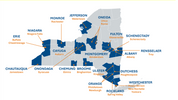Multistory warehouses have gained popularity in the U.S. over the past five years, catering to the evolving demands of the market. Today, let's explore the reasons behind their appeal and the impact they have on urban logistics.
First and foremost, warehouses have long been attractive to landlords due to their versatility. Like traditional big-box warehouses, multistory warehouses offer the advantage of accommodating multiple tenants across various industries. But unlike traditional big-box warehouses, they offer landlords the ability to maximize the use of available land by constructing vertically, providing multiple levels for tenants.
In particular, the resurgence of people moving to urban areas--like downtown Buffalo, NY--has created a need for multistory warehouses. The rise of e-commerce and the need for faster delivery times have fueled the demand for well-located, urban warehouses. Multistory warehouses, many of which are strategically positioned near urban centers, provide a solution that can meet these evolving needs while minimizing the impact on surrounding infrastructure.
But these warehouse-type buildings are not limited to serving logistics needs. For example, with downtown apartments--and therefore less storage space--becoming increasingly popular, self-storage facilities have become a viable solution for apartment-dwellers. Additionally, as more people move to these downtown apartments, there has become a need for grocery stores nearby. Multistory warehouses, with their vertical design and efficient use of space, provide an ideal solution for meeting each of these demands.
This year marks the 5-year anniversary of multistory warehouse development in the U.S., a subset of buildings within the Urban Logistics inventory. These buildings differ from traditional big-box warehouses and have emerged to meet the growing demand and changing consumer behavior.
 unknownx500
unknownx500










